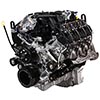I have done numerous searches and reading up on compression height.
As I understand it, compression height is optimized for a given application. My assumptions my be right may be wrong.
For naturally aspirated high revving engines a short compression height is usually used. Longer rod, lighter piston. Higher revs.
For nitrous builds and one would generally want more compression height specifically the top ring being lower down in the piston to protect the ring from excessive heat and or to give the piston more thermal mass to deal with the effects of nitrous combustion. As long as a rod as you can get without sacrificing piston strength, I remember seeing a video with Mike Finnegan talking about changing his plans on a 598 and going with a smaller stroke because of questionable piston strength.
What I'm curious about is compression height for longevity, take for instance a Ford V10 F550/F650 that alot of towing and delivery companies use. This has a compression height of 1.3182 (if I did the calculation right). I see alot of OEM pistons generally keep the oil ring out of the wrist pin (avoiding the need for a support ring) I think this is done for longevity, particularly on a engine that racks up 50,000 miles per year.
Engines like this rev low, and maybe rod ratio isn't that critical, because the piston speed stays low.
For example. a 540 can be built different ways, 9.8 deck, 6.385 rod, leaves a 1.29 Compression height. With a 6.135 rod you get 1.54. (My math maybe off, hope its close)
If this engine only sees 4500 or 5500 rpms is the longer rod more advantageous or the taller compression height?
I realize this may not be a typical question here. For a weekend warrior or a drag car that gets rebuilt every season. But for something like hot shot trucking where miles rack up fast and 150,0000+ miles between rebuilds are expected compression height may be important.
I know there are alot of smart people out there. A closed mind never gets fed, so I thought I would make this post
Note:
I'm aware of diesel engines and their capabilities.
As I understand it, compression height is optimized for a given application. My assumptions my be right may be wrong.
For naturally aspirated high revving engines a short compression height is usually used. Longer rod, lighter piston. Higher revs.
For nitrous builds and one would generally want more compression height specifically the top ring being lower down in the piston to protect the ring from excessive heat and or to give the piston more thermal mass to deal with the effects of nitrous combustion. As long as a rod as you can get without sacrificing piston strength, I remember seeing a video with Mike Finnegan talking about changing his plans on a 598 and going with a smaller stroke because of questionable piston strength.
What I'm curious about is compression height for longevity, take for instance a Ford V10 F550/F650 that alot of towing and delivery companies use. This has a compression height of 1.3182 (if I did the calculation right). I see alot of OEM pistons generally keep the oil ring out of the wrist pin (avoiding the need for a support ring) I think this is done for longevity, particularly on a engine that racks up 50,000 miles per year.
Engines like this rev low, and maybe rod ratio isn't that critical, because the piston speed stays low.
For example. a 540 can be built different ways, 9.8 deck, 6.385 rod, leaves a 1.29 Compression height. With a 6.135 rod you get 1.54. (My math maybe off, hope its close)
If this engine only sees 4500 or 5500 rpms is the longer rod more advantageous or the taller compression height?
I realize this may not be a typical question here. For a weekend warrior or a drag car that gets rebuilt every season. But for something like hot shot trucking where miles rack up fast and 150,0000+ miles between rebuilds are expected compression height may be important.
I know there are alot of smart people out there. A closed mind never gets fed, so I thought I would make this post
Note:
I'm aware of diesel engines and their capabilities.





